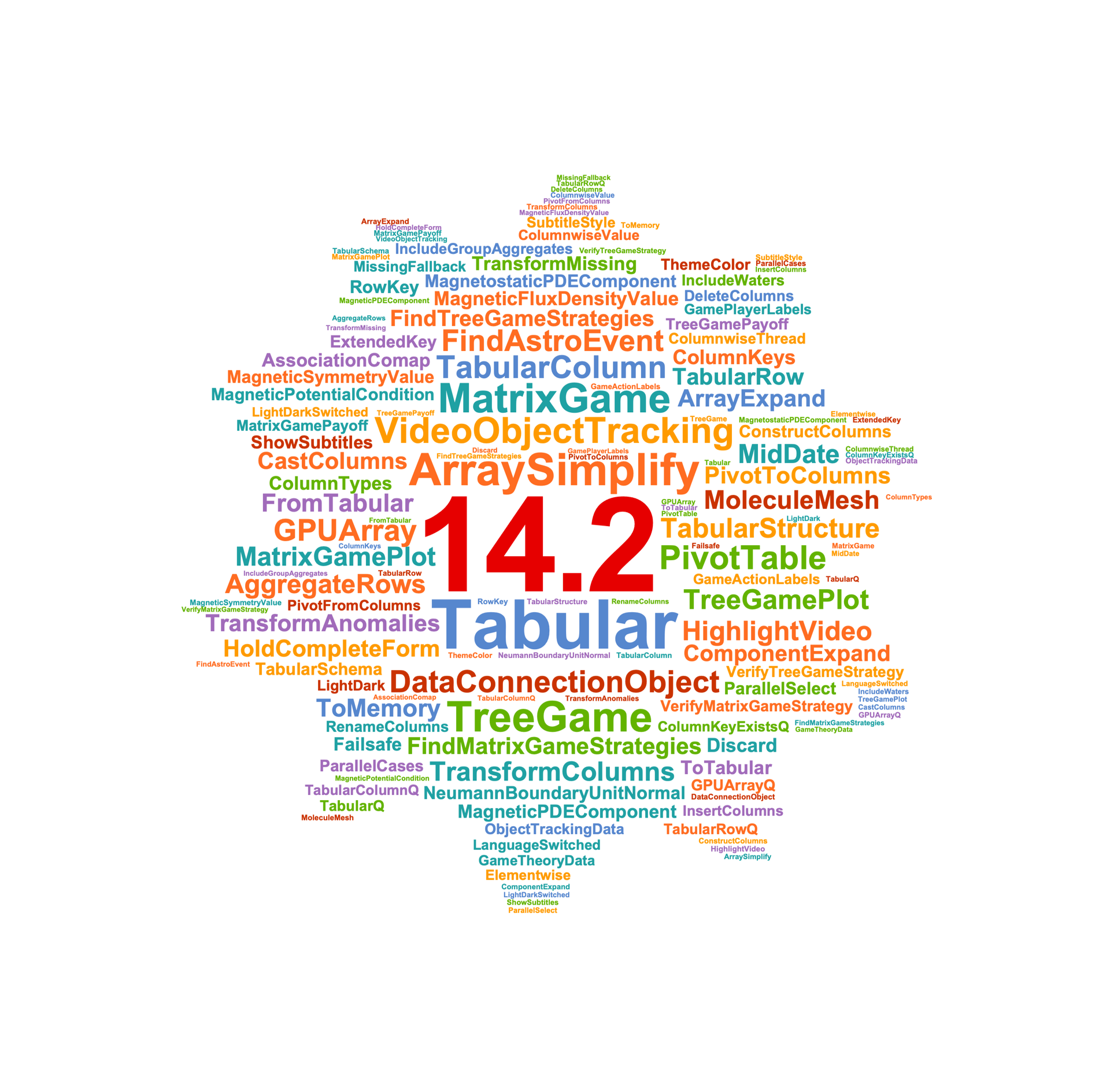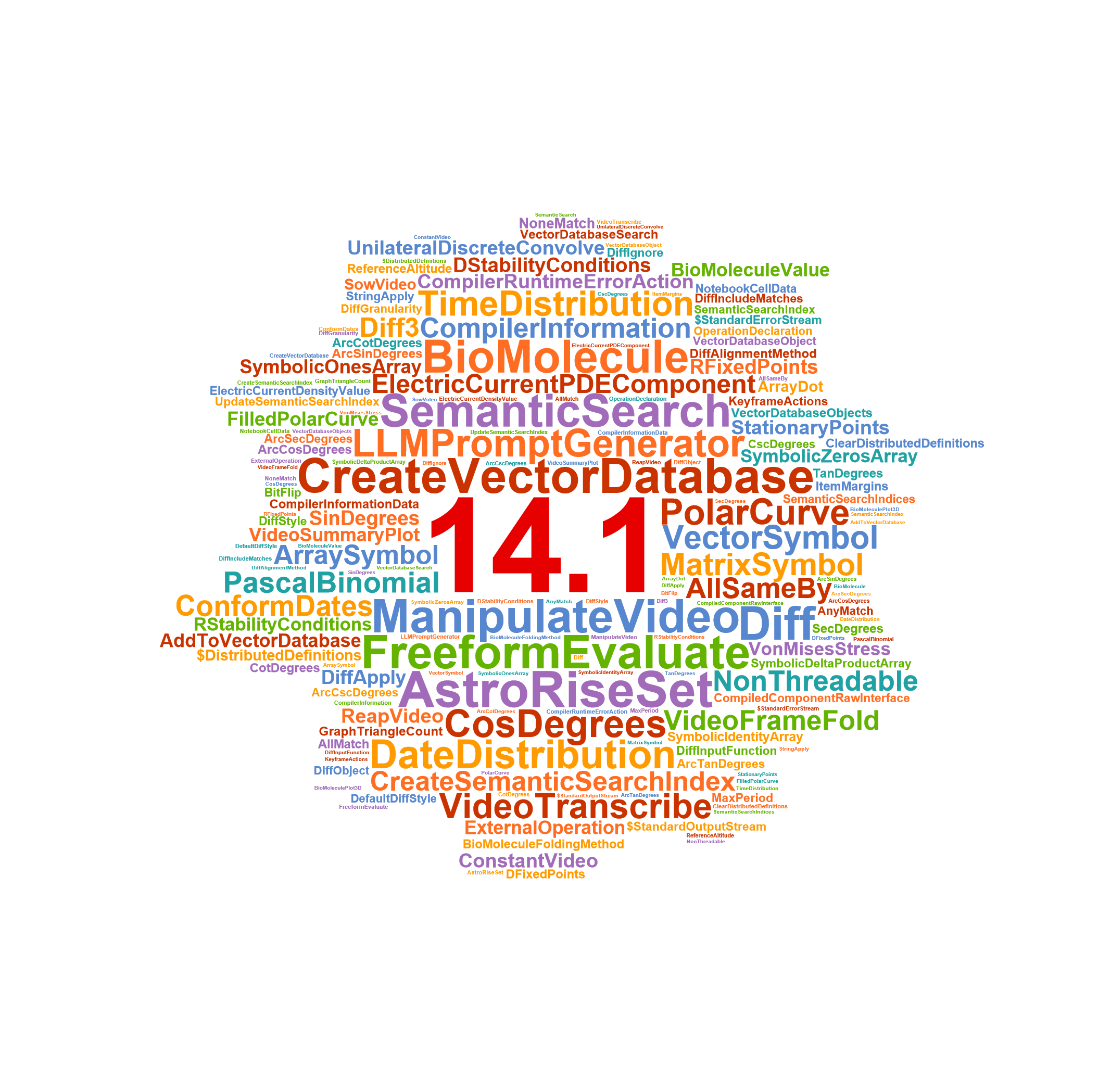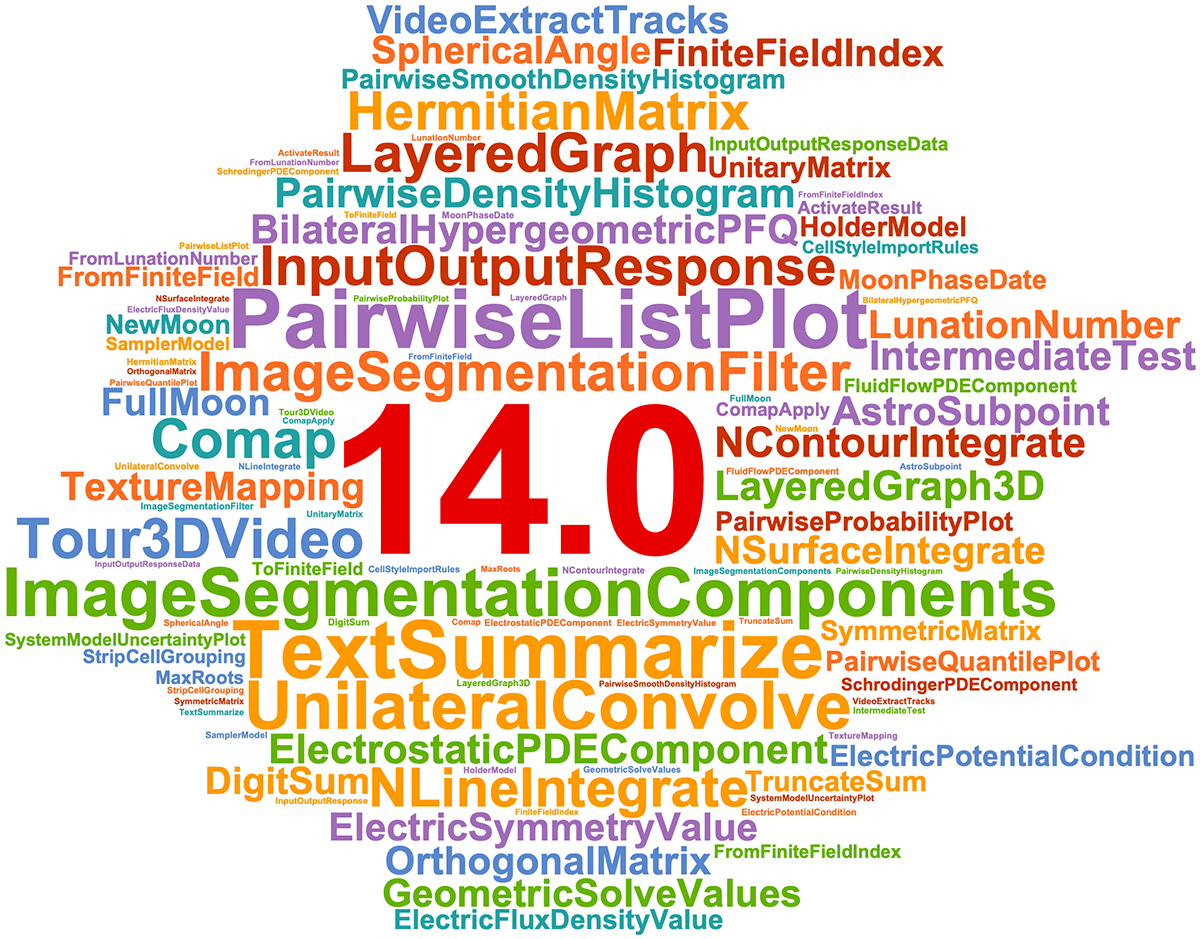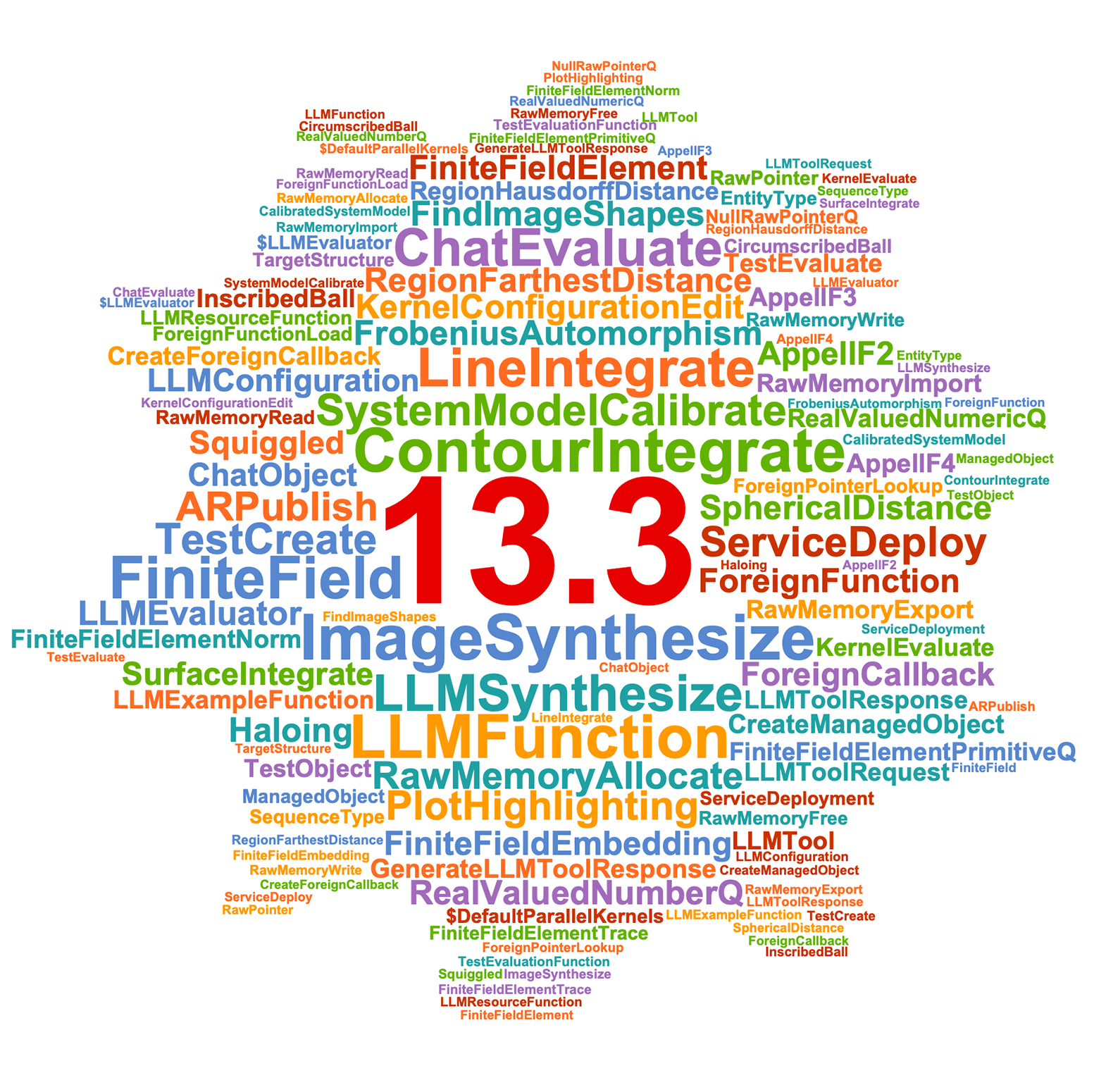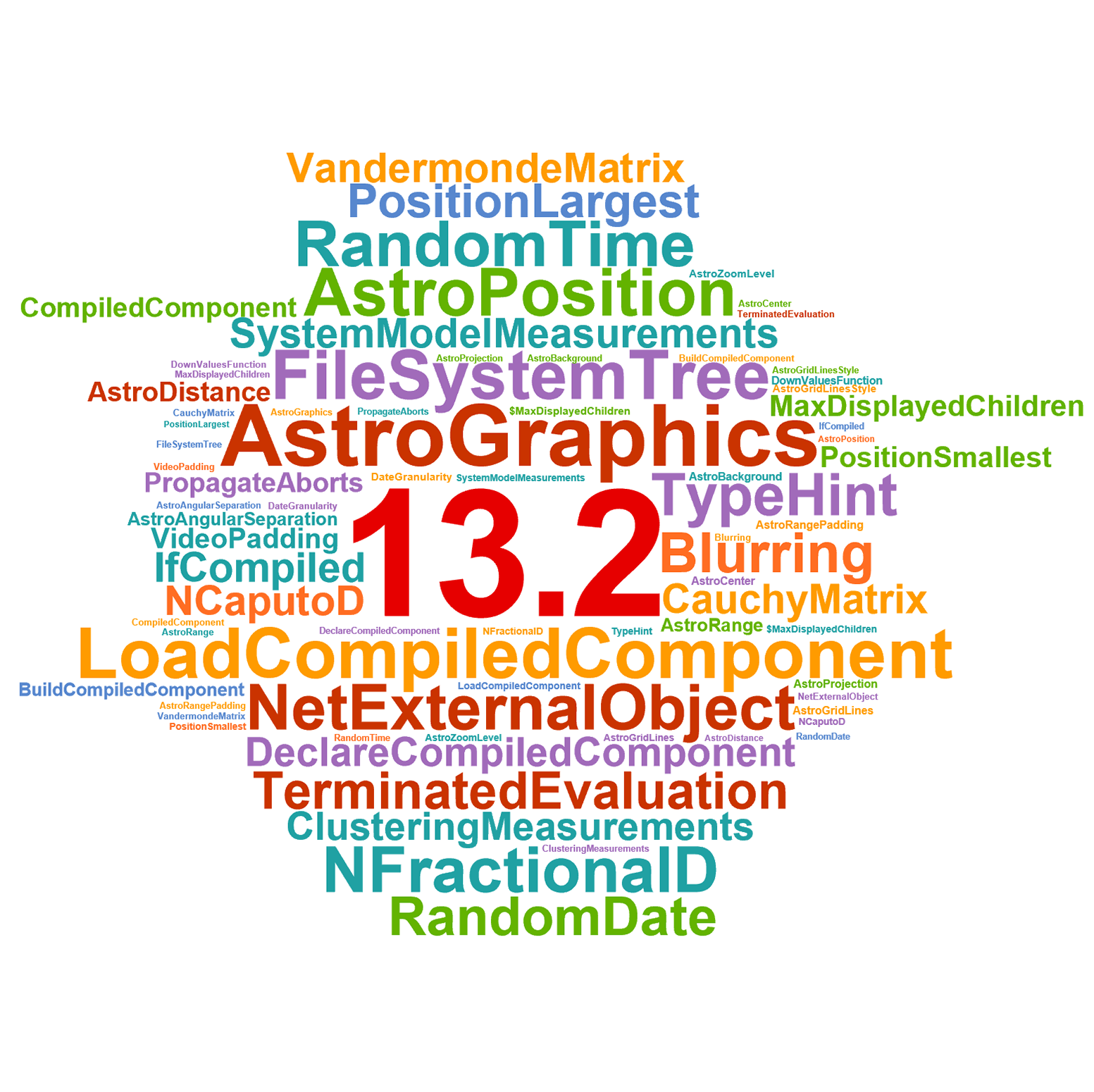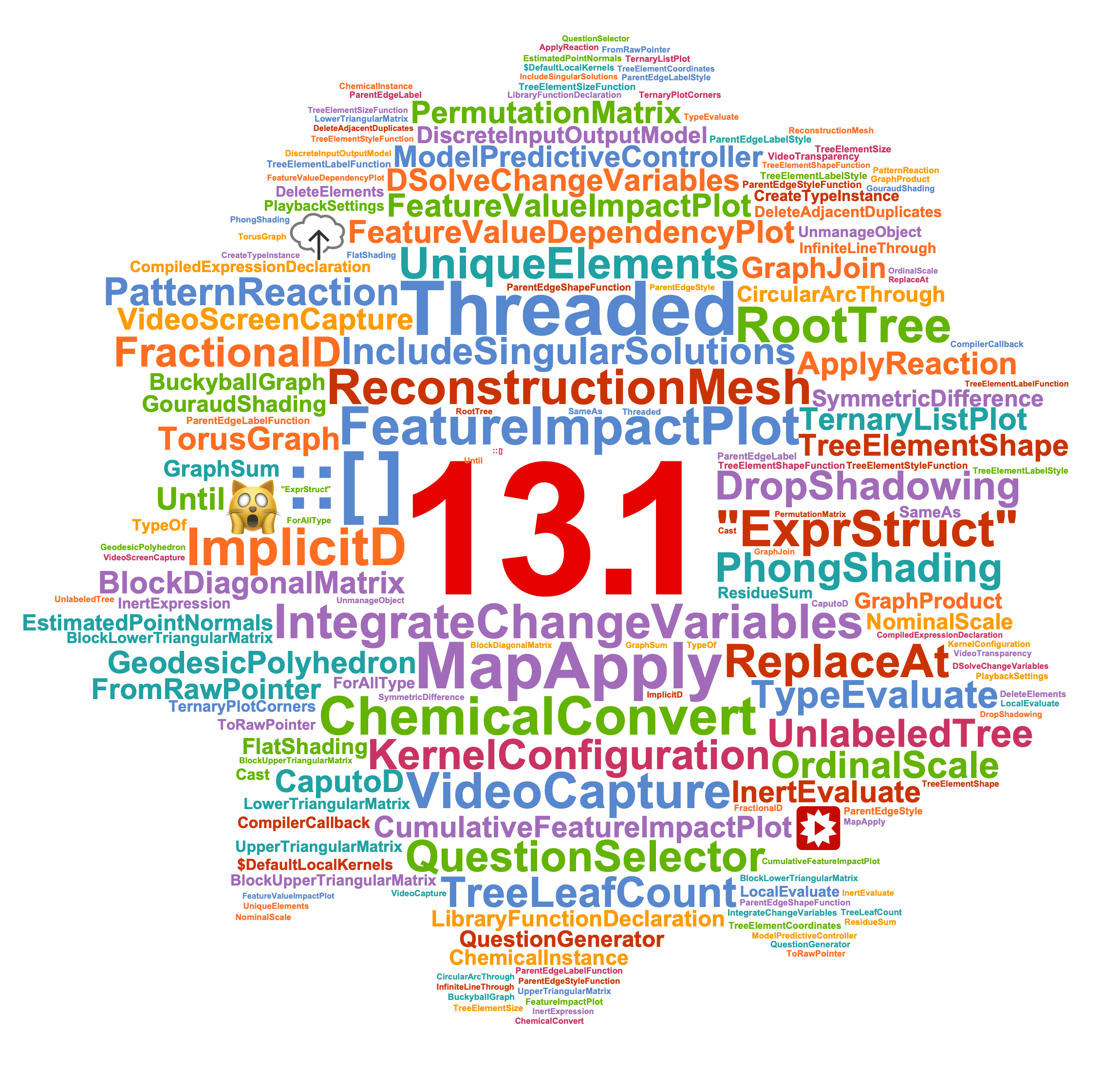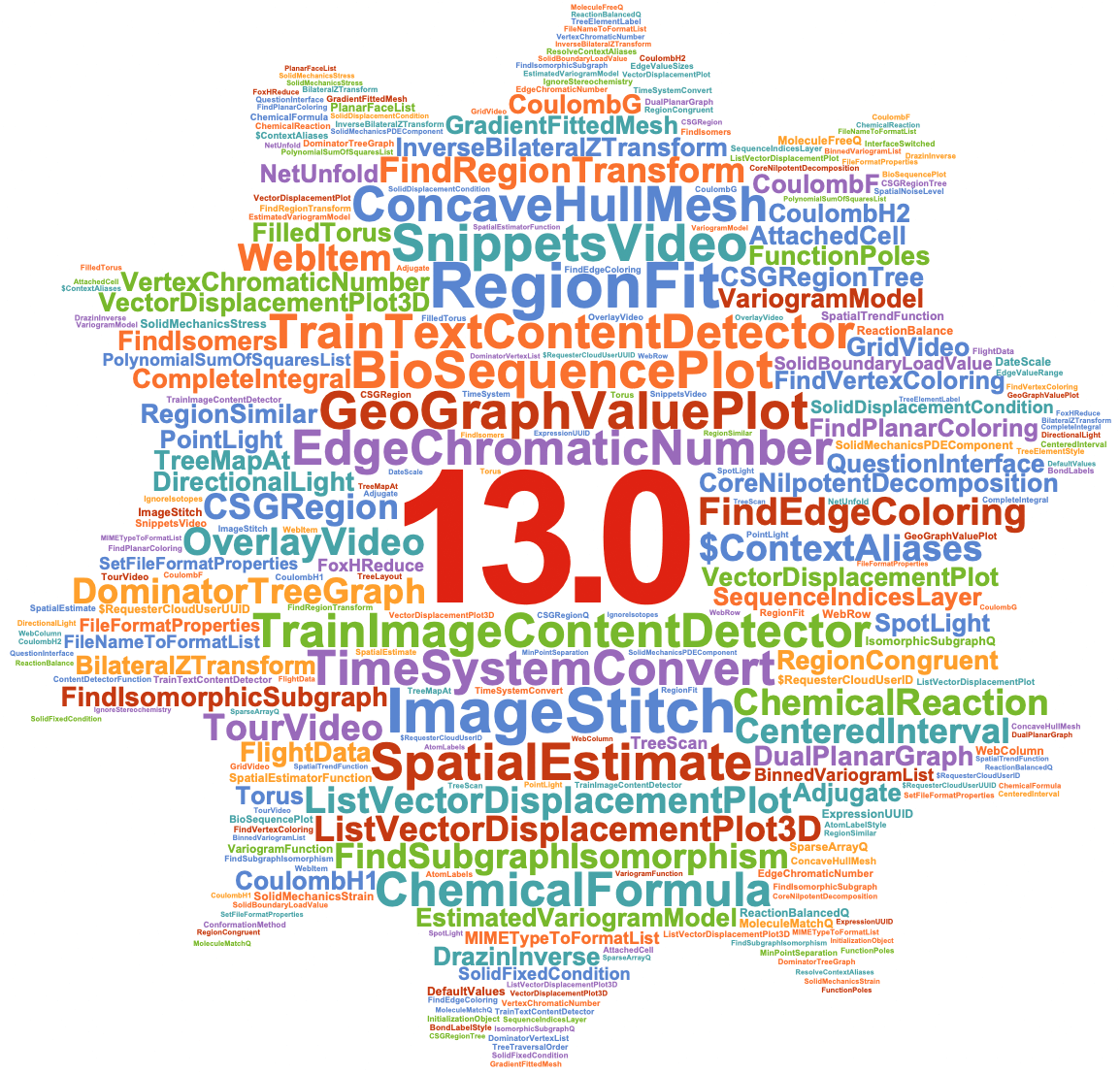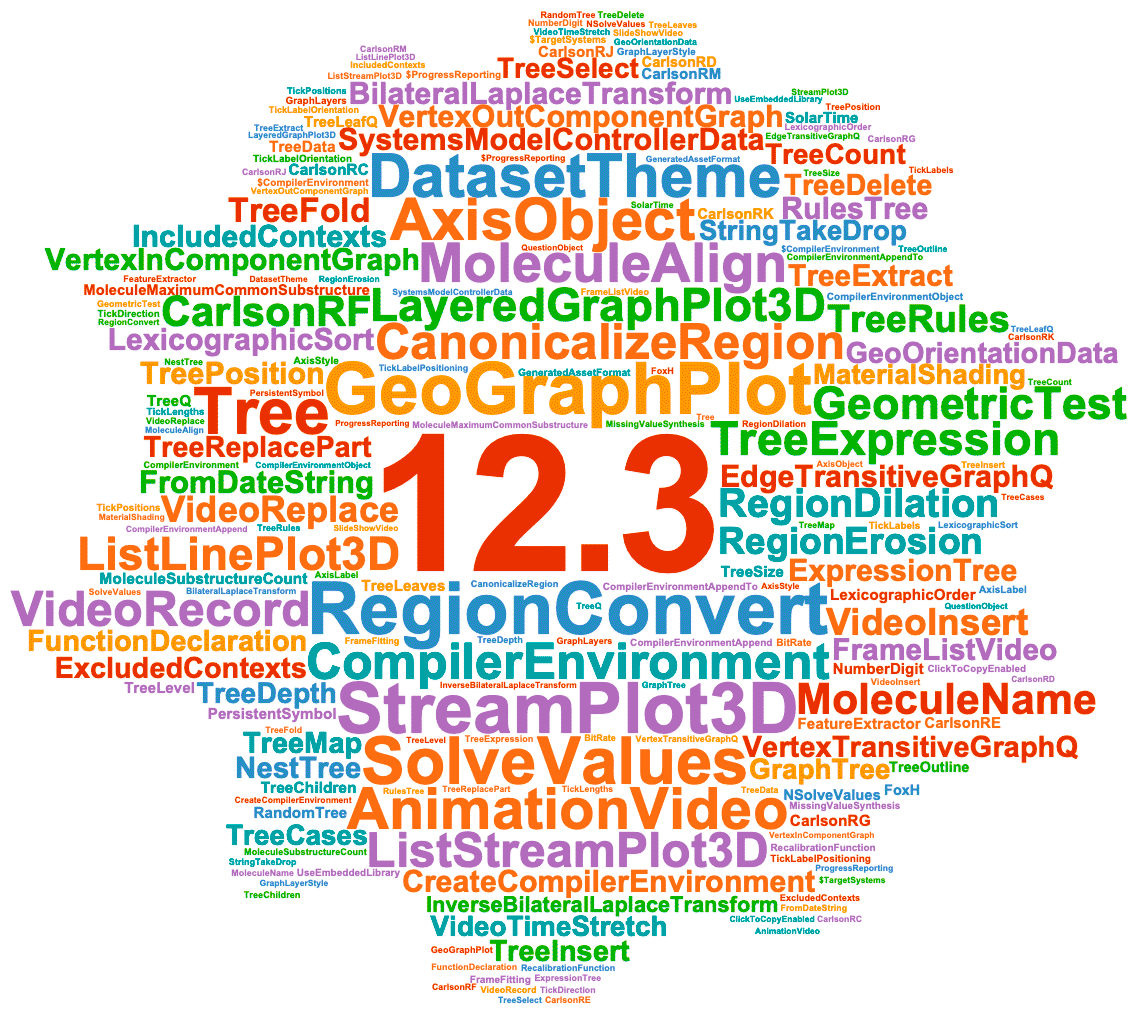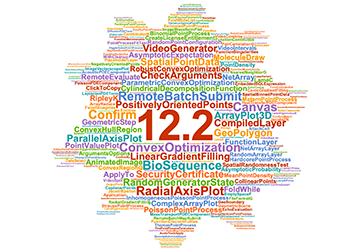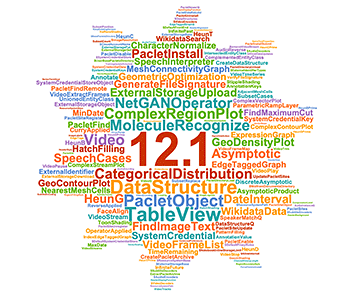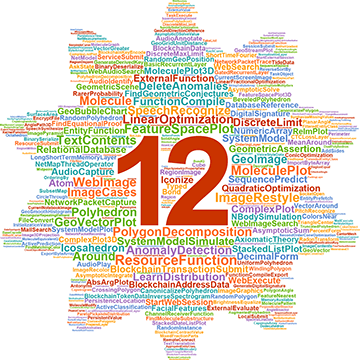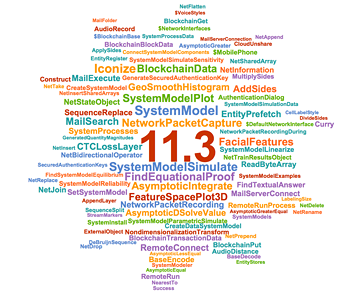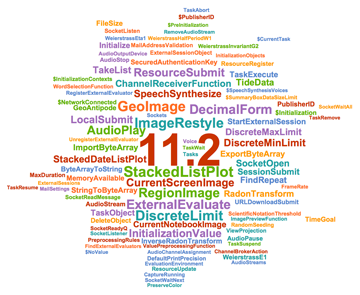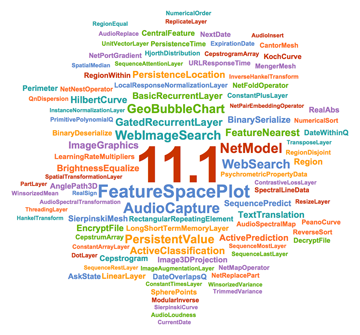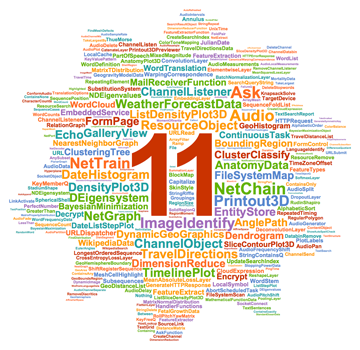 Mathematica 14.2.1
Mathematica 14.2.1
| April 2025
Version 14.2.1 includes critical updates for Chatbook and code captions along with other bug fixes and stability improvements.
 Mathematica 14.2
Mathematica 14.2
| January 2025 | 14.2 Documentation
Version 14.2 introduces a powerful tool in Tabular, which provides a very streamlined and efficient way to handle tables of data laid out in rows and columns, with hundreds of other functions enhanced to make use of its special features. Additional new functions and improvements have been added to enhance neural nets and LLMs, work with game theory, improve GPU computation, and expand images and videos.
- Create a version of a function protected against bad input with Failsafe
- Delete elements not obeying a criterion function with Discard
- Use AssociationComap to create an association by applying a list of functions to a value
- Display an expression completely shielded from evaluation with HoldCompleteForm
- Tabular represents column-oriented tabular data with different types, missing values, etc.
- ToTabular converts to Tabular with detailed control
- Multiple new functions introduced to support Tabular operations: FromTabular, TabularQ, TabularColumn, TabularRow, TabularSchema, ColumnKeyExistsQ, TabularQ, TabularColumnQ and TabularRowQ
- Several built-in functions have been updated to support Tabular natively, including Part, Take, Drop, TakeDrop, Key, KeyDrop, KeyTake, Select, Discard, TakeSmallestBy, TakeLargestBy, MaximalBy and MinimalBy
- Many Import formats have been added or updated to support tabular data, such as CSV, XLSX, XLS, ODS, SXC, TSV, Table, Parquet, ArrowIPC, ORC, ArrowDataset, SAV, SAS7BDAT, DTA, POR, XPORT, RData, RDS and DIF
- DataConnectionObject allows for connecting to data stores (with authentication, queries, etc.) such as "AmazonS3", "AzureBlobStorage", "Dropbox" and "IPFS"
- DatabaseReference updated to allow relational databases to be used as out-of-core back ends for Tabular
- Return an in-memory version of an out-of-core object with ToMemory
- Handle missing and outlier values in tabular data with TransformMissing and TransformAnomalies, respectively
- Spread values from a single column into several columns with PivotToColumns; inversely, gather values from several columns into one column with PivotFromColumns
- Use TransformColumns to compute columns from values in each row
- Perform simple or grouped aggregation with AggregateRows
- Compute a pivot table with multiple row and column pivots and aggregation with PivotTable
- Many visualization functions have been updated to support plotting values from tabular columns, including BarChart, PieChart, BubbleChart, Histogram, DateHistogram, ListPlot, ListLinePlot, ListPlot3D, StackedListPlot, DateListPlot and more
- Perform asynchronous LLM generation with LLMSynthesizeSubmit and ChatSubmit
- Multiple machine learning and neural network functions have been updated to support Tabular, including Classify, Predict, ClassifierMeasurements, PredictorMeasurements, FindClusters, LearnDistribution, FeatureExtraction, DimensionReduce, FeatureSpacePlot, NetTrain and NetMeasurements
- Represent a simultaneous game specified by payoff matrices or arrays with MatrixGame
- Find Nash equilibria in a MatrixGame with FindMatrixGameStrategies
- Visualize matrix games and strategies with MatrixGamePlot
- Represent a sequential game specified by a game tree with TreeGame
- Find subgame perfect equilibria (SPE) for a TreeGame with FindTreeGameStrategies
- Visualize tree games and strategies with TreeGamePlot
- Simplify or expand symbolic array expressions with ArraySimplify and ArrayExpand, respectively
- Use ComponentExpand to expand a symbolic array expression into its component parts
- Find the instant of relevant astronomical events with FindAstroEvent
- MidDate computes the midpoint date of a granular date or list of dates
- GPUArray stores data in memory accessible for GPU-accelerated computation
- Multiple built-in functions have been updated to support GPUArray, including ArrayDepth, Dimensions, Length, Part, Dot, Transpose, ConjugateTranspose, Diagonal, Tr, LinearSolve, Fourier, SeedRandom, RandomInteger, Mean, Variance, Min, Max, Plus, Times, Total, Sin, Cos, Tan, ArcSin, Exp, Log and more
- Detect and track objects in a video with VideoObjectTracking
- Highlight objects in a video with HighlightVideo
- Use SubtitleStyle to specify style for created subtitle tracks
- MagnetostaticPDEComponent models magnetostatics without currents
- MagneticPDEComponent models quasistatic magnetic fields with currents
In addition to the features introduced in Version 14.2, 908 bugs were fixed in this release cycle.
- AstroGraphics has wrong default AstroRange when plotting data over the whole sky (452857)
- Variance of WeightedData objects returns wrong value (452706)
- STL exporting can create incomplete models (451972, 452302)
- DateListPlot missing X-axis ticks when specifying FrameTicks (450764)
- ListAnimate jumps to the beginning with fps specified and AnimationRepetitions -> 1 (333899)
- An integral involving a positive integrand over a four-dimensional unit cube is giving a negative result on macOS (427726)
 Mathematica 14.1
Mathematica 14.1
| July 2024 | 14.1 Documentation
Version 14.1 introduces the unified Wolfram application and expands Wolfram Language by offering new tools for working with neural nets and LLMs, for finding differences in content, for working with images and videos, and for exploring scientific evaluations through biomolecules, astrophysics and more.
- Flip one of the bits of an integer number with BitFlip
- Added several functions to test elements of a list: AllSameBy, AllMatch, AnyMatch, NoneMatch
- LLMPromptGenerator allows adding context-dependent messages to an LLM prompt
- Search in a text corpus by semantic similarity with SemanticSearch
- Create and update semantic similarity indices with CreateSemanticSearchIndex and UpdateSemanticSearchIndex
- New service connections to LLMs: AlephAlpha, GoogleGemini, MistralAI, Cohere, DeepSeek, TogetherAI and Groq
- Create, update and search vector databases with CreateVectorDatabase, AddToVectorDatabase and VectorDatabaseSearch
- Support for symbolic vector, matrix and array symbols with VectorSymbol, MatrixSymbol and ArraySymbol
- Added support for symbolic vectors, matrices and array inputs to numerous functions, including D, Grad, Div, Laplacian, Transpose, TensorTranspose, Dot, Cross, TensorContract and more
- Standard constructors needed for symbolic vector, matrix and array formulas added: SymbolicZerosArray, SymbolicOnesArray, SymbolicIdentityArray and SymbolicDeltaProductArray
- Stability analysis for systems of differential equations added with DStabilityConditions
- Stability analysis for systems of difference equations added with RStabilityConditions
- Added versions of the trigonometric functions for use with degree arguments: SinDegrees, CosDegrees, TanDegrees, CotDegrees and more
- PascalBinomial is a binomial that preserves Pascal's identity for all integers
- Conform a list of dates or times to have shared granularity and calendar with ConformDates
- Descriptive statistics functions like Mean, Median, Variance, Correlation and others have been updated to work on dates and time data
- AstroRiseSet computes rise and set times for any astronomical object, observed anywhere on any date
- PolarCurve represents curves in polar coordinates
- Count triangle cycles in a graph with GraphTriangleCount
- ManipulateVideo creates a video from Manipulate using keyframe parameters
- Sow video snippets to later reap the full video with SowVideo and ReapVideo
- VideoFrameFold transforms a video using a stateful iteration
- Add a subtitle track to video from audio transcription with VideoTranscribe
- Plot a summary of the video and audio tracks with VideoSummaryPlot
- Multiple functions that take audio input, such as AudioAmplify and AudioNormalize, now also work on video input
- ElectricCurrentPDEComponent models electric currents in PDEs
- VonMisesStress computes the von Mises stress from a stress tensor
- View the differences between two notebooks, files, strings, lists, etc. with Diff
- Perform a three-way diff on supported diff targets with Diff3
- Apply a diff change set to an existing object with DiffApply
- FunctionCompile has been updated and now reports progress and gives a detailed report on compilation errors; it also now supports the CompilerRuntimeErrorAction option, which controls behavior when errors are encountered running compiled code
- Symbolic representation of external operations added with ExternalOperation
- $DistributedDefinitions and ClearDistributedDefinitions return and clear the list of all symbols whose definitions have been distributed to parallel subkernels, respectively
In addition to the features introduced in Version 14.1, 1,280 bugs were fixed in this release cycle.
- DateObject does not parse ISO 8601 week dates correctly (446892)
- GeoBounds can give incorrect results when subregions touch (445429)
- ImageToolbar coordinates tool does not return the correct (x, y) coordinate values (410592)
- MeanAround returns inconsistent results with Quantities (409665)
 Mathematica 14
Mathematica 14
| January 2024 | 14.0 Documentation
Version 14.0 continues to expand the scope and breadth of our computational coverage while streamlining and polishing existing areas.
- Apply a list of functions to an expression with Comap and ComapApply
- DigitSum computes the sum of the individual digits in an integer
- UnitConvert is now faster
- Create intermediate tests inside TestCreate using IntermediateTest
- Compute numerical vector line integrals, vector surface integrals or complex contour integrals using NLineIntegrate, NSurfaceIntegrate and NContourIntegrate, respectively
- UnilateralConvolve performs unilateral (AKA causal, one-sided) convolutions
- TruncateSum makes it easy to work with infinite sum representations produced by DSolve and other functions
- Convert expressions to and from finite field versions with ToFiniteField and FromFiniteField
- Convert to and from finite field index representation with FiniteFieldIndex and FromFiniteFieldIndex
- Several new structured matrix types added: SymmetricMatrix, HermitianMatrix, OrthogonalMatrix and UnitaryMatrix
- TextSummarize automatically produces different types of summarization of text data
- Multiple new visualization functions added for plotting all pairwise 2D projections of data: PairwiseListPlot, PairwiseDensityHistogram, PairwiseSmoothDensityHistogram, PairwiseQuantilePlot and PairwiseProbabilityPlot
- SolarEclipse has been overhauled; support was added for more than seventy thousand eclipses and 50 new properties
- Functions for computing the date of a new moon, a full moon or any moon phase added: NewMoon, FullMoon and MoonPhaseDate
- Create a graph represented as a layered plot with LayeredGraph and LayeredGraph3D
- Specify named texture mappings for graphics with TextureMapping
- ImageSegmentationComponents segments an image into components
- ImageSegmentationFilter filters an image for the foreground components
- Create a tour around 3D graphics with Tour3DVideo
- Several new PDE modeling functions added: SchrodingerPDEComponent, FluidFlowPDEComponent, ElectrostaticPDEComponent and more
- Create detailed simulation results for discrete, continuous or mixed control systems with InputOutputResponse
- Plot outcome uncertainties from uncertain parameters, initial values and inputs in a control system model with SystemModelUncertaintyPlot
- Support added for importing DOCX, MOBI, RData and RDS formats
- Support for subtitle import and export added to the MP4, QuickTime and Matroska formats
- New data structures added: RedBlackTree and StringVector
- Spline-related graphics primitives BezierCurve, BSplineCurve and BSplineSurface are now also valid geometric regions for computational geometric operations, such as ArcLength and RegionMeasure
In addition to the features introduced in Version 14.0, 2,037 bugs were fixed in this release cycle.
- Element[ArcCos[5 Sqrt[3]], Algebraics] crashes the kernel if the Suggestions Bar is enabled (442256)
- Save Graphic As EPS with file name that already exists causes the front end to become unresponsive (442572)
- FindClusters[RandomVariate[ExponentialDistribution[1], 100]] throws strange ArrayComponents error message (442018)
- Classify fails to evaluate for more than 1,000 classes (438909)
- BinomialDistribution with n = 1 does not equal BernoulliDistribution (404655)
- JLink doesn't handle Java NaNs well (78789)
- Manipulates with ControlType -> TogglerBar don't autorun correctly (70794)
- RegionPlot and RegionPlot3D clip ImplicitRegion (304783)
 Mathematica 13.3.1
Mathematica 13.3.1
| August 2023
Version 13.3.1 includes multiple critical bug fixes and improvements to Chat-Enabled Notebook stability and usability.
 Mathematica 13.3
Mathematica 13.3
| June 2023 | 13.3 Documentation
Version 13.3 introduces new functions that utilize large language models, as well as expands functionality for machine learning, mathematical computations, foreign function interface and more.
- Added many new functions for calling large language model (LLM) functionality programmatically and for allowing LLMs to access Wolfram Language tools: ChatObject, ChatEvaluate, LLMFunction, LLMSynthesize, LLMTool and more.
- Edit properties for a given kernel with KernelConfigurationEdit.
- Symbolic representation and manipulation of unit tests with TestCreate, TestObject, TestEvaluate and TestEvaluationFunction.
- Compute vector line integrals with LineIntegrate and vector surface integrals with SurfaceIntegrate.
- Perform complex contour integration with ContourIntegrate.
- Support for the Appell bivariate hypergeometric special functions: AppellF2, AppellF3 and AppellF4.
- Multiple new functions added and updated to represent finite fields and finite field elements and perform polynomial computations over finite fields, including FiniteField, FiniteFieldElement, FiniteFieldEmbedding, FiniteFieldElementNorm, MinimalPolynomial and MultiplicativeOrder.
- Multiple linear algebra functions have been updated to support structured matrices with compact representation and fast computation, controlled by the new TargetStructure option.
- Statically or dynamically highlight specific elements in visualizations with Highlighted and set global highlighting effects for visualizations with PlotHighlighting.
- Calibrate a system model's parameters with measurement data using SystemModelCalibrate.
- Publish 3D graphics and geometries to AR devices with ARPublish.
- Added support for the "USD" and "GLTF" AR formats for mobile devices.
- Measure how different two regions are with RegionHausdorffDistance and compute the farthest distance between two regions with RegionFarthestDistance.
- Compute the minimal enclosing ball for a set of points with CircumscribedBall and compute the maximum inscribed ball with InscribedBall.
- Haloing creates a halo around a graphics object, typically used for text labels.
- ImageSynthesize generates an image from a textual prompt.
- FindImageShapes finds common shapes (lines, circles, ellipses, ...) in an image.
- New functions to represent, load and get pointers to functions in dynamic libraries: ForeignFunction, ForeignFunctionLoad and ForeignPointerLookup.
- Several functions added for raw memory operations: RawMemoryAllocate, RawMemoryFree, RawMemoryRead, RawMemoryWrite, RawMemoryImport and RawMemoryExport.
- Support for memory-managed objects with ManagedObject, CreateManagedObject and UnmanageObject.
 Mathematica 13.2.1
Mathematica 13.2.1
| February 2023
Version 13.2.1 includes over a hundred bug fixes, feature enhancements, performance improvements and security updates.
 Mathematica 13.2
Mathematica 13.2
| December 2022 | 13.2 Documentation
Version 13.2 introduces new functionality in astronomy and compilation, as well as substantially enhancing functions for machine learning, trees, mathematical computations, video and more. This release also includes over a thousand bug fixes, documentation enhancements and significant performance improvements.
- Improved performance of several Quantity operations.
- Uniformly distributed random sampling of dates and times with RandomDate and RandomTime.
- Fine-tuned abort handling using PropagateAborts.
- Faster univariate and multivariate polynomial operations.
- Added support for modular factoring of multivariate polynomials.
- Faster symbolic linear algebra involving matrices with univariate rational functions.
- Two new structured matrix types: VandermondeMatrix and CauchyMatrix.
- Numerical fractional differentiation with NFractionalD.
- Numerical Caputo differentiation with NCaputoD.
- Many functions and options related to astronomical computation and visualization have been added, including AstroPosition, AstroDistance, AstroAngularSeparation and AstroGraphics.
- Soften or hide features in graphics using Blurring.
- Analyze the result of a clustering process with ClusteringMeasurements.
- Represent an external model that can be used for inference with NetExternalObject.
- FileSystemTree creates a tree of subdirectories and files in a directory.
- Compute step response analytics for control systems with SystemModelMeasurements.
- Support for geographical data formats "GXF" and "OSM".
- Support for popular chess game formats "FEN" and "PGN".
- Build, load and install components, such as a shared library, from a compiled component with CompiledComponent, DeclareCompiledComponent, BuildCompiledComponent and LoadCompiledComponent.
- Additional support for migration from evaluated code to compiled code with TypeHint and IfCompiled.
 Mathematica 13.1
Mathematica 13.1
| June 2022 | 13.1 Documentation
Version 13.1 includes 90 completely new functions—plus 203 functions with substantial updates, new user interface features and enhanced compiler functionality.
- Thread arrays at deep levels of other arrays with Threaded
- New language convenience functions for list manipulation: DeleteElements, DeleteAdjacentDuplicates, SymmetricDifference and UniqueElements
- Added functional programming convenience functions: ReplaceAt, MapApply, Until and SameAs
- Compute change of variables in integrals and differential equations with IntegrateChangeVariables and DSolveChangeVariables
- Support for fractional derivatives and fractional differential equations with FractionalD, CaputoD and an update to DSolve
- Compute derivatives of implicitly defined functions using ImplicitD
- Added several new types of structured arrays: PermutationMatrix, BlockDiagonalMatrix, LowerTriangularMatrix, UpperTriangularMatrix, BlockLowerTriangularMatrix and BlockUpperTriangularMatrix
- Interval evaluation via CenteredInterval or Interval added to multiple special mathematical functions
- Plot ratios of quantities with TernaryListPlot
- Enhanced support for the ScalingFunctions option in visualization functions, and added NominalScale and OrdinalScale
- VoronoiMesh now supports 3D Voronoi decompositions
- Reconstruct 1D, 2D and 3D meshes from point clouds using ReconstructionMesh
- EstimatedPointNormals can estimate normals to points in a point cloud
- Added functions for operations on graphs: GraphProduct, GraphJoin and GraphSum
- Emoji and more multilingual support
- Create 2D drop shadow effects with DropShadowing
- Several new shaders for graphics added: FlatShading, GouraudShading and PhongShading
- Interactive video recording from webcams and other devices with VideoCapture
- Interactive screen video recording with VideoScreenCapture
- New machine learning functions to plot impact of features on a model result: FeatureValueImpactPlot, FeatureImpactPlot, CumulativeFeatureImpactPlot and FeatureValueDependencyPlot
- New tree-related functions RootTree, UnlabeledTree, TreeLeafCount and numerous options to style and label trees
- Represent a family of chemical reactions symbolically with PatternReaction and apply such a reaction to a set of molecules with ApplyReaction
- Perform chemical conversions with ChemicalConvert
- ModelPredictiveController performs explicit constrained MPC controller design with 1-, 2- and ∞-norms
- DiscreteInputOutputModel implements a general nonlinear input output model
- New functions for type declaration and type specification syntax in compiled code and libraries: TypeDeclaration, CompiledExpressionDeclaration, LibraryFunctionDeclaration and TypeSpecifier
- Expanded support for type representation in compiled code with ForAllType, LiteralType, TypeEvaluate, CreateTypeInstance and TypeOf
- Call the evaluator from compiled code with InertEvaluate
- Create and dereference pointers for interacting with external libraries with ToRawPointer and FromRawPointer
- Added an "ExprStruct" data structure that represents an expression that can be modified without evaluation
- QuestionGenerator and QuestionSelector add further support for question & answer interfaces
- New default toolbar, annotation overlay and custom guide page creation
- All new and updated features since 13
 Mathematica 13.0.1
Mathematica 13.0.1
| February 2022
Version 13.0.1 continues an ongoing effort of incremental quality development of Wolfram Language. This release includes hundreds of bug fixes, feature enhancements and performance improvements, including a security update for log4j.
 Mathematica 13
Mathematica 13
| December 2021 | 13.0 Documentation
Version 13.0 adds a total of 117 completely new functions, but also many hundreds of updated and upgraded functions, several thousand bug fixes and small enhancements, and a host of new ideas to make the system ever easier and smoother to use.
- Create convenient aliases for context names using $ContextAliases
- New linear algebra functions: Adjugate, DrazinInverse and CoreNilpotentDecomposition
- Implemented several Coulomb wavefunctions: CoulombF, CoulombG, CoulombH1 and CoulombH2
- Perform interval computations for real and complex centered intervals using CenteredInterval
- Compute the bilateral or double-sided Z transform and the inverse transform using BilateralZTransform and InverseBilateralZTransform
- Create 2D and 3D displacement plots using new functions VectorDisplacementPlot, VectorDisplacementPlot3D, ListVectorDisplacementPlot and ListVectorDisplacementPlot3D
- Visualize geo flows via GeoGraphValuePlot
- New constructive solid geometry region CSGRegion, built by Boolean operations on basic regions
- Create regions from a set of points using RegionFit, GradientFittedMesh and ConcaveHullMesh
- Find an affine transform from one region to another with FindRegionTransform and check for congruity and similarity for two regions using RegionCongruent and RegionSimilar
- New functions for finding isomorphic subgraphs and subgraph isomorphisms: IsomorphicSubgraphQ, FindSubgraphIsomorphism, FindIsomorphicSubgraph
- Find minimal edge and vertex colorings for graphs with FindEdgeColoring and FindVertexColoring
- Find face coloring for a planar graph layout using FindPlanarColoring
- Compute dominators for directed graphs using DominatorTreeGraph and DominatorVertexList
- New lighting options for three-dimensional graphics: AmbientLight, DirectionalLight, PointLight and SpotLight
- Create spatial predictions with SpatialEstimate
- Estimate the best variogram model for location-tagged data with EstimatedVariogramModel
- New video processing functions: SnippetsVideo, TourVideo, GridVideo and OverlayVideo
- Preview videos in a Wolfram Language notebook with a new built-in video player
- Stitch a list of images together with ImageStitch
- Efficiently train custom content detectors using TrainImageContentDetector and TrainTextContentDetector
- Extract a repeating operation in a folded neural net with NetUnfold
- New additions to the Tree framework: TreeScan, TreeMapAt, TreeTraversalOrder and TreeLayout
- Convert between different time systems with TimeSystemConvert
- Get real-time information on airplane flights using FlightData
- New solid mechanics PDE model functions, including SolidMechanicsPDEComponent, SolidMechanicsStrain, SolidMechanicsStress and more
- Added symbolic representations for chemicals and chemical reactions: ChemicalFormula, ChemicalReaction
- Compute a chemically balanced reaction with ReactionBalance and check if a given reaction is balanced with ReactionBalancedQ
- Improved import of PDF pages as vector graphics
- Use QuestionInterface to specify an interface for answering questions
- Represent an HTML element containing an expression with WebItem and arrange such elements into rows and columns with WebRow and WebColumn
- Submit remote batch jobs to the Azure Batch service
- GeoGraphics now returns maps with vector labels by default
 Mathematica 12.3.1
Mathematica 12.3.1
Version 12.3.1 continues an ongoing effort of incremental quality development of Wolfram Language and Mathematica.
- Native support for macOS for Apple Silicon
- Streamlined product activation for site licenses supporting single sign-on
- New Wolfram|Alpha-Mode notebook features, including 2D typesetting for math constructs, additional support for chemical computations and biomolecular sequences and interactive plot quizzes
- Numerous other feature enhancements, bug fixes and performance improvements
 Mathematica 12.3
Mathematica 12.3
| May 2021
|
12.3 Documentation
With more than a hundred new functions, a thousand bug fixes and many substantially updated and enhanced functions, Version 12.3 delivers an important incremental release that makes Mathematica and Wolfram Language more complete, faster, smoother and more convenient to use across many different areas.
- Get direct solution values for equations with SolveValues and NSolveValues
- Carlson elliptic integral functions have been implemented, as well as the Fox H-function
- Compute the bilateral or double-sided Laplace transform and its inverse with BilateralLaplaceTransform and InverseBilateralLaplaceTransform
- Plot streamlines for vector field functions and vector field data with StreamPlot3D and ListStreamPlot3D
- Plot lines through 3D data with ListLinePlot3D
- Display a graph plot with geographic vertices on a map with GeoGraphPlot
- New framework for the construction and manipulation of symbolic trees
- Solve and Reduce now support systems of transcendental equations
- Root now supports multivariate roots
- DSolve now solves any linear system of ODEs with rational function coefficients and any linear ODE with q-rational function coefficients
- New AxisObject to represent a generalized quantitative axis
- MaterialShading allows for realistic rendering of surface material
- Change the representation of a region with CanonicalizeRegion and RegionConvert
- Test whether geometric objects satisfy given properties or relations with GeometricTest
- Generate different kinds of videos with AnimationVideo, SlideShowVideo and FrameListVideo
- Improved video processing capabilities, including addition of VideoRecord, VideoTimeStretch, VideoInsert and VideoReplace
- Parse date strings using locale, time zones and more with FromDateString
- Implemented SystemsModelControllerData, generated from control design functions with rich data needed to connect and analyze the closed-loop system
- New computational chemistry functions including MoleculeName, MoleculeSubstructureCount and MoleculeAlign
- Improvements to several import and export formats and additions of new formats such as SAS7BDAT, DTA and POR
- Support for Java, Octave and system shells added to ExternalEvaluate
- Control the overall appearance of Dataset output with DatasetTheme
- New data structures added: "ImmutableVector" and "KDTree"
- The function Around has been reimplemented and is now significantly faster
- New features since 12.2
 Mathematica 12.2
Mathematica 12.2
| December 2020
|
12.2 Documentation
Version 12.2 adds 228 new functions, expanding Mathematica and Wolfram Language's functionality in biomolecular sequence operations, PDE modeling, spatial statistics and remote batch job evaluation, plus new notebook interface features and more.
- Represent a biological sequence such as DNA with BioSequence and perform operations on it with functions BioSequenceTranscribe, BioSequenceComplement, etc.
- New PDE modeling framework for solving a wide variety of partial differential equations both symbolically and numerically
- Analyze spatial data and work with point processes with new spatial statistics functions such as SpatialPointData, RandomPointConfiguration, MeanPointDensity, PointCountDistribution and more
- Submit batch jobs for asynchronous evaluation on external computation providers with RemoteBatchSubmit and RemoteBatchMapSubmit
- Use Enclose and Confirm to write code with more robust error handling
- CheckArguments and ArgumentsOptions help check for valid positional and optional arguments in function definitions
- New x|->f syntax for defining pure functions with named variables
- Use ApplyTo (//=) to apply a function to a variable and update its value
- Conveniently select dates from date intervals or lists with DateSelect
- Improve code debugging and tuning with new EchoEvaluation, EchoLabel and EchoTiming functions
- New theories and properties added to AxiomaticTheory
- Solve general convex optimization problems with ConvexOptimization
- Find solutions to robust optimization problems with RobustConvexOptimization and to parametric convex optimization problems with ParametricConvexOptimization
- Test for various function properties with FunctionInjective, FunctionSign, FunctionContinuous, etc.
- Improved support for elliptic functions, including addition of the JacobiEpsilon and JacobiZN (Jacobi zeta) functions
- Mathematical Lamé functions LameS, LameC, LameSPrime, LameCPrime, LameEigenvalueA and LameEigenvalueB for solving boundary value problems for Laplace's equation in ellipsoidal and spheroconal coordinates
- Create radar plots with RadialAxisPlot
- ParallelAxisPlot creates parallel coordinate plots
- Represent 2D geographic regions with GeoPolygon, a new GeoGraphics primitive
- Artistically fill 2D graphics primitives with LinearGradientFilling, RadialGradientFilling and ConicGradientFilling
- Test convexity and compute the convex hull of any region with ConvexRegionQ and ConvexHullRegion
- Check if a set of points is positively oriented, negatively oriented, collinear or coplanar with PositivelyOrientedPoints, NegativelyOrientedPoints, CollinearPoints and CoplanarPoints, respectively
- Greatly improved support for video computation, with new functions such as VideoGenerator, VideoIntervals, VideoDelete, VideoMap, VideoMapTimeSeries and more
- New AnimatedImage object to represent animated GIF, PNG, etc.
- Use FaceRecognize to find and recognize faces in an image using machine learning
- Support for several new neural network layer types, including FunctionLayer, CompiledLayer, NetArrayLayer and RandomArrayLayer
- Several new methods for DimensionReduction and DimensionReduce have been added, including t-SNE, principal component analysis and latent semantic analysis
- Support for compression and archival formats 7z, ISO, RAR and ZSTD
- Represent public-key security certificates with SecurityCertificate and import them from common variants of the PEM file format
- Significant improvement to PDF import
- Improved Import with support for URLs, updates to FileFormat and addition of FileFormatQ and more
- Attach a floating cell to content in a notebook window with AttachCell
- Canvas adds interactive free-form drawing in the notebook interface
- Create a button that copies its contents when clicked with ClickToCopy
- Redesigned interface for inserting and editing hyperlinks
- Added support for inline TeX input with automatic typesetting
- Create on-demand license entitlements to run standalone Wolfram Engine kernels on a pay-as-you-go basis with CreateLicenseEntitlement
- Improved Microcontroller Kit with new support for many 32-bit targets from Arduino, Adafruit and SparkFun
- New features since 12.1
 Mathematica 12.1.1
Mathematica 12.1.1
| June 2020
Version 12.1.1 is the result of an ongoing effort of incremental quality development of Wolfram Language. It includes almost a thousand bug fixes, feature enhancements and performance improvements in cryptography, video processing, data science, visualization and more.
- Cryptography functions are more robust and consistent, including additional hashing methods for GenerateDigitalSignature
- VideoStream now supports livestreams, and video processing and export functions use H264/AAC codecs by default (when available)
- Improved performance for Dataset and GridBox constructs and increased stability for TableView
- RLink can now use custom R installations up to Version 3.6
- Improved data handling for StackedListPlot and StackedDateListPlot
- Improvements and fixes for Around, including better handling of asymmetric uncertainties
- Better typesetting for DateObject
- Resolved a slowdown in prime-number computations
- And more
 Mathematica 12.1
Mathematica 12.1
| March 2020 | 12.1 Documentation
Version 12.1 is our biggest point release so far, expanding Mathematica and Wolfram Language's functionality in mathematical visualization, audio and image processing, machine learning and neural networks, data access/storage, and more, as well as introducing new systems for video processing and paclet management.
- Windows and Linux notebook interface updated with HiDPI support for thousands of icons and other assets
- Windows and macOS interfaces now use Direct3D 11 and Metal API for improved rendering of 3D graphics
- Spreadsheet-like viewing, editing and manipulation of tabular data with TableView
- Detailed control of appearance, sorting, data storage and other options for Dataset
- New DataStructure framework for efficient creation, storage and manipulation of common data structures
- Compute asymptotic approximations and expansions for mathematical expressions with Asymptotic and DiscreteAsymptotic
- Mathematical HeunG function representing the regular solution of the general Heun equation
- Generate distributions over unordered classes with CategoricalDistribution
- Use GeometricOptimization to find positive values that minimize the posynomial objective subject to given constraints
- Plot functions, regions and vectors in the complex plane with ComplexRegionPlot, ComplexContourPlot, ComplexVectorPlot, etc.
- Support for generating proofs from arbitrary predicates (first-order logic) with FindEquationalProof
- Several improvements and new options for vector visualization
- Artistically fill 2D polygons with HatchFilling and PatternFilling, and shade 3D objects with StippleShading, ToonShading, HatchShading and other new graphics directives
- Improved support for geometric operations on geographic regions
- Display values on maps as smoothly varying colors with GeoDensityPlot or as contours with GeoContourPlot
- Explore the topology of meshes with MeshConnectivityGraph and NearestMeshCells
- Train generative models on various types of data with NetGANOperator
- Include anomaly detection in machine learning functions with AnomalyDetector
- Set styled annotations for graphs and other objects with Annotate
- Use Splice to automatically splice expressions into a list
- Operate on subsets/sublists with functions such as SubsetCases, SubsetPosition, SubsetCount, etc.
- Represent operator forms with OperatorApplied and CurryApplied, and use ReverseApplied to apply a function with arguments reversed
- TimeRemaining for retrieving the seconds until a TimeConstrained computation will be terminated
- DateInterval for representing time intervals continuously or at a given granularity, InfinitePast/InfiniteFuture for representing indefinite time intervals and MinDate/MaxDate for finding extrema in an interval or list of dates
- View tree graphs of expressions at any level with ExpressionGraph
- ExternalIdentifier for representing and referencing resources in external identifier systems
- Search and retrieve values from Wikidata's SPARQL endpoint with WikidataSearch and WikidataData
- Support for Julia, Ruby and R languages through ExternalEvaluate
- Identify molecular structures in an image with MoleculeRecognize
- Upload files to an external storage such as Dropbox with ExternalStorageUpload
- View and analyze ARK blockchain data and submit transactions
- Combine and separate entity classes with UnionedEntityClass, IntersectedEntityClass and ComplementedEntityClass
- Improved support for ZIP and TAR through CreateArchive and ExtractArchive
- Securely store system passwords, secrets, keys, etc. locally with SystemCredential, and create digital file signatures from a given key with GenerateFileSignature
- Paclet framework for representing, installing and managing local and remote paclets with functions such as PacletInstall, PacletFind, PacletSites, etc.
- Improved support for MicrosoftSQL, MySQL and other relational databases
- Solve the max-cut problem for a graph with FindMaximumCut
- Use FaceAlign to align faces in images based on facial landmarks
- FindImageText for detecting the regions of an image containing a character, word, line or block of text
- Use SpeechCases and SpeechInterpreter to identify text and entities in spoken audio, and compare speech with a reference clip with SpeakerMatchQ
- Sophisticated video framework for programmatic viewing, processing and analysis of a range of multimedia types
- Use CharacterNormalize to convert text to various Unicode normalization forms
- Support for user-provided CUDA Toolkits
- Create notebooks with free-form, Wolfram|Alpha-like input and output, ready for multistep computations
- New features since 12
 Mathematica 12
Mathematica 12
| April 2019 | 12.0 Documentation
Version 12.0 greatly expands Mathematica's functionality in mathematics and geometry, geographic visualization, audio and image processing, machine learning and more, including major front end enhancements and system-wide performance improvements.
- Major OS integration updates to Mac and Linux notebook interfaces using the 64-bit Cocoa API and Qt 5, respectively, with the Linux interface no longer requiring a supporting X server
- Optimization solvers such as LinearOptimization, QuadraticOptimization, SemidefiniteOptimization, etc. for optimizing convex functions over convex constraints, including vector inequalities such as VectorGreater for modeling vector-valued variables
- Expanded asymptotics functionality, including asymptotic solutions to algebraic and difference equations and asymptotic approximations to sums
- Added support for generating arbitrary constants in Integrate, Sum and Product
- Improved elementary functions support for Integrate, support for large structured systems in Solve and Reduce, DSolve support for nonlinear first-order ODEs and extended coverage and support in FunctionDomain
- Extended numerical PDE-solving capabilities of NDSolve to solve nonlinear PDEs over arbitrary-shaped regions with the finite element method, and automated idealized n-body interactions using NBodySimulation
- Geometric capabilities have been further enhanced with the addition of general polygons with holes and polyhedra primitives, as well as improved support across the board
- New framework to visualize Euclidean geometry and its theorems using GeometricScene and GeometricAssertion
- Access built-in axiomatic theories for use in symbolic proofs with AxiomaticTheory
- Visualize complex-valued data and functions using ComplexListPlot, plot real and imaginary components of a function using ReImPlot and plot the modulus of a complex function of a real variable colored by its argument using AbsArgPlot
- Use Around to describe uncertainty in measured values, with built-in support in visualization functions
- Create, analyze and modify chemical species using the Molecule function, and visualize structures in two and three dimensions with MoleculePlot and MoleculePlot3D
- Represent geodetic vectors with GeoVector, and visualize geodetic vector fields using GeoVectorPlot and GeoStreamPlot
- Generate randomly distributed geo positions in any region using RandomGeoPosition, and analyze distance, area and angular distortion of geo projections using GeoGridUnitDistance, GeoGridUnitArea and GeoGridDirectionDifference
- Updated default appearance for GraphPlot visualizations, as well as new plot themes and updated properties
- Color-processing functions such as FindMatchingColor, ImageRecolor and ColorDetect, all powered by the new ColorsNear wrapper to represent a color neighborhood
- High-level recognition functions such as ImageCases, FacialFeatures, AudioIdentify and SpeechRecognize, and performance enhancements to FindFaces, FeatureSpacePlot, AudioMFCC, etc.
- Performance improvements in audio analysis functions such as AudioIntervals and windowing functions such as HannWindow, and a new AudioAnnotate framework for annotating audio objects
- Multi-language support for SpeechSynthesize, as well as improved discovery and searching of available voices through VoiceStyleData
- ShortTimeFourier for computing and storing properties of short-time Fourier transforms, and InverseSpectrogram for approximating a signal from a magnitude spectrogram
- The neural network framework has been enhanced with additional pre-trained models, new layers, new encoders and decoders, multi-GPU support and automatic early stopping of training to prevent overfitting
- ClassifierMeasurements can now handle uncertainties and multi-class averaging, and the "NeuralNetwork" method for Classify has been vastly improved using a self-normalizing net
- Learn a generalized probability distribution from arbitrary data using LearnDistribution, replace missing values in data by generated values using SynthesizeMissingValues and find anomalous examples in data using FindAnomalies
- Interact with relational databases symbolically using RelationalDatabase, integrating out-of-core and in-memory techniques to access terabyte-scale data and automatically generating SQL code for popular databases
- Query remote or in-memory RDF graph databases using SPARQL queries, and import/export RDF data from a variety of RDF formats
- Support for "on-the-fly" properties, filtering and sorting, aggregation, combining types and sampling of classes in the entity framework
- Expanded and enhanced data for built-in entities across all domains, including geographic, cultural and historic, life science and medical, financial, astronomical, earth science, transportation, engineering, linguistic and mathematical
- Efficient partial import and other improvements in scientific formats such as "FITS" and "HDF5", as well as tabular formats such as "CSV" and "XLS"
- NumericArray for creating the most compact representation of a numeric array
- Pass arguments to functions in any order or bracket structure with Curry, or map vector functions onto sublists of elements with SubsetMap
- Information has been greatly extended and modernized to provide information on different object types
- Initial version of Wolfram Compiler for translating portions of Wolfram Language code into optimized native machine code
- Improvements to the external evaluation framework, including core performance enhancements, ExternalFunction to directly call external code and WebExecute to control web browsers
- Create, sign and deploy custom blockchain transactions and interact with computational contracts using BlockchainTransaction, BlockchainTransactionSign, BlockchainTransactionSubmit and BlockchainContractValue
- New Microcontroller Kit for automating the generation and deployment of code to microcontrollers
- Bidirectional interface to the Unity game engine
- Share notebooks to the Wolfram Cloud or via email without leaving the front end
- Create, store and instantly access functions through the public Wolfram Function Repository and the ResourceFunction system
- And more
 Mathematica 11.3
Mathematica 11.3
| March 2018 | 11.3 Documentation
Version 11.3 expands Mathematica and Wolfram Language's functionality in mathematical computation, audio and image processing, machine learning and neural networks, system modeling and more, as well as introduces several new front end features.
- Expanded asymptotics functionality, including relational operators and approximate solutions to integrals and differential equations
- Apply algebraic operations to both sides of equations and inequalities with ApplySides, and find proofs for equational logic theorems from axioms with FindEquationalProof
- Create smooth intensities of locations on a map with GeoSmoothHistogram
- FeatureSpacePlot3D for plotting dimension-reduced feature spaces in 3D
- CurrentImage support for simultaneous multi-device capture and Linux image capture
- FacialFeatures extracts facial characteristics such as age, emotion and landmarks, and FindFaces can filter based on these features
- Efficient audio net encoding and feature extraction for in-core and out-of-core audio objects
- SpeechSynthesize supports native OS synthesis, and AudioDistance can be used to compute distance measures for audio signals
- FindTextualAnswer for finding the part of a text that answers a question, improved automation for Classify and Predict and new methods for DimensionReduction
- Additional pre-trained models, faster RNN training, efficient sequence generation, training session summaries, array sharing, 3D and variable-length convolutions and surgery on networks have been added to the neural network framework
- Browse, import or generate simulation-ready system models for data extraction, analysis and visualization
- Blockchain framework for accessing current information about blockchains (e.g. Ethereum or Bitcoin) and storing/retrieving data using a Wolfram blockchain
- New systems-level functionality for remote process execution, user authentication, process management and network packet capture
- Directly process mail in live mailboxes by searching, flagging, moving, deleting, etc.
- SendMail supports HTML emails and automatically embeds objects such as Dataset, TimeSeries and more
- Improved support for system modeling, raster image, audio, tabular, spreadsheet, systems and network formats
- Prefetch entities and register custom entities and entity types for immediate computation using the EntityStore system
- Wolfram Presenter Tools environment for creating live, interactive technical presentations
- Exchange text, code and other content in real time using the notebook-based Wolfram Chat interface
- New features since 11.2
 Mathematica 11.2
Mathematica 11.2
| September 2017 | 11.2 Documentation
Version 11.2 expands Mathematica and Wolfram Language's cutting-edge functionality in audio and image processing, mathematical computation, task handling and machine learning—plus much more.
- Compute undirected and multivariate limits, upper and lower limits or discrete limits
- Solve directly for limiting values in continuous or discrete equations
- FourierTransform support for periodic functions
- Perform 3D Boolean operations on regions
- New methods and options for automated machine learning, with support for extracting word vectors, audio and sequences
- Expanded neural network layer types with new options and methods
- Additional support for neural network import/export formats
- ImageRestyle to recreate one image based on the features of another
- Get satellite images with GeoImage
- RegionImage for 3D rasterization of regions
- Capture the current screen or notebook with CurrentScreenImage and CurrentNotebookImage
- SpeechSynthesize for generating spoken audio from expressions
- Support for stereo audio, programmatic audio playback and Linux audio capture
- Connect to external language interpreters with ExternalEvaluate and StartExternalSession
- ZeroMQ network programming through the SocketConnect framework
- Framework for configuring initialization values and computations
- Manage asynchronous and background tasks with the TaskObject framework
- Additional documentation for low-level numerical linear algebra
- New features since 11.1
 Mathematica 11.1.1
Mathematica 11.1.1
| April 2017
Mathematica 11.1.1 resolves critical issues identified in Version 11.1 and includes performance improvements.
- Reenabled GPU support for neural networks for Mac
- Several updates and fixes to neural networks, including proper support for HDF5 format
- Fixed slowdown in documentation lookup
- LinearModelFit no longer uses excessive memory
- Fixed rendering issue with ListPlot3D
- Fixed incorrect behavior of Suggestions Bar and attached cells on Windows
- Region operations on rectangles with packed array coordinates no longer crash
 Mathematica 11.1
Mathematica 11.1
| March 2017 | 11.1 Documentation
Version 11.1 extends Mathematica and Wolfram Language's state-of-the-art capabilities in machine learning, neural nets, audio processing, robust statistics and much more.
- Over 130 new functions across a wide range of application areas
- 20 new neural net layer types, and seamless support for recurrent nets and variable-length sequences
- NetModel to access a growing repository of complete trained and untrained neural nets
- FeatureSpacePlot for machine-learning-based visualization of spaces of data, images, text, etc.
- New machine learning functions, including SequencePredict, ActiveClassification and ActivePrediction
- Record audio directly in notebooks using AudioCapture, readying it for immediate processing and analysis
- Do arithmetic (with *, -, etc.) directly on 2D and 3D images
- Extended support for computational photography and computational microscopy
- ImageGraphics to find vector graphic approximations to bitmaps
- Space-filling and fractal region constructors such as HilbertCurve and SierpinskiMesh
- New robust and spatial statistics, including WinsorizedMean and SpatialMedian
- GeoBubbleChart, as well as extended support for Callout, ScalingFunctions, etc.
- Support for derivatives with symbolic orders
- Higher-resolution geo elevation data
- Seamlessly integrated external services for web search, web image search and text translation
- Broad PersistentValue system for storing values between sessions locally, in the cloud, etc.
- AutoCopy for seamless distribution of separately editable notebooks in the cloud
- Creation of WolframScript .wls files with a notebook-based script editor
- Self-executing Wolfram Language scripts extended to Windows
- New, responsive design for all documentation and online examples
 Mathematica 11.0.1
Mathematica 11.0.1
| September 2016
Mathematica 11.0.1 resolves critical issues identified in Mathematica 11 and adds many feature refinements.
- New Audio support for Linux, and improved audio behavior on all platforms
- Fixed Graphics3D rotation and magnification bug that caused system to crash
- Significantly improved GIF import performance
- Fixed regression in Plot and dramatic slowdowns in ParametricPlot, ParametricPlot3D
- ListPlot labeling and callout functionality now exhibit expected behavior
- Improved performance and stability of Dataset and related functionality
- Over 9,000 words added to the English spellchecking dictionary
- TextRecognize now correctly supports all documented languages
- Fixed an issue with WolframScript's ability to differentiate between options and script names
- Compatibility with macOS Sierra and improved stability on other Mac and Linux platforms
- Resolved partial evaluation and other errors thrown by CenterArray
- Enabled SetOptions for URLRead, URLExecute and URLDownload
 Mathematica 11
Mathematica 11
| August 2016 | 11.0 Documentation
Mathematica 11 introduces functionality for major new areas, including 3D printing, audio processing, machine learning and neural networks—plus many other new improvements, all built on the underlying Wolfram Language.
- Over 500 new functions significantly broaden scope in new and existing areas
- Algorithmically generate, import and directly print 3D models to local or cloud 3D printers
- New computational audio synthesis, processing and analysis for applications in music and speech
- New neural network framework gives access to GPU-accelerated deep learning
- Expanded and enhanced machine learning functionality, including feature extraction and Bayesian optimization
- Numerous extensions and improvements to the Wolfram Cloud and web operations and data storage
- Vast new array of visualizations, from statistical to geographic to anatomical, and improved presentation options
- Performance and feature enhancements to already industry-leading symbolics, numerics and geometry
- Expanded geographics, including new geo data entities, map backgrounds, projections and more
- New computational photography, plus more tools for image and signal processing
- New and improved support for random matrices, time series and quantities in probability and statistics
- Experimental Wolfram channel framework for asynchronous communications between cloud, desktop and embedded systems
- Execute Wolfram Language code from anywhere—locally or in the cloud—with new WolframScript command-line interpreter
- Richer functional programming constructs thanks to list- and array-processing enhancements
- More powerful text and language processing, and increased multilingual support
- Real-time spellchecker augmented with dictionaries for technical terms, proper names and support for some 25 languages
- Improved code appearance, autocompletion and error messages help increase user productivity
- Faster, more flexible access to the growing Wolfram Knowledgebase, including support for arbitrary datasets
- And more
 Mathematica 10.4.1
Mathematica 10.4.1
| April 2016
Mathematica 10.4.1 addresses several critical issues identified in recent releases.
- Provides workaround for a bug in Mac OS X 10.11.4 that could prevent Mathematica from being launched under default Gatekeeper policies
- Resolves OpenGL issues that were causing graphics instability and failures, especially with regard to Graphics3D and Manipulate rendering, rotation and dynamics
- Addresses activation problems for Linux users who may have experienced difficulties
- Resolves slowdown when images are directly evaluated in the front end
- Restores expected behavior for users experiencing errors when launching multiple notebooks on Windows
- Corrects evaluation errors returned by ListPlot [Table[…]] and CoefficientRules
- Restores behavior of Clear Formatting menu item
- Show now works with GeoGraphics objects
- Stability improvements to Code Assist functionality
- Refines support and documentation for DateFormat when using Interpreter
- For Japanese Edition users, updated dialog messages returned when moving a notebook from the cloud to the desktop
 Mathematica 10.4
Mathematica 10.4
| March 2016 | 10.4 Documentation
Mathematica 10.4 capitalizes on the newest version of Wolfram Language to deliver significant functionality gains for cloud services and systems, geographic and geometric computation, dynamic visualization, creating interactive applications and a robust array of other improvements.
- Support for pattern matching and significant speedup in many operations for Association
- Ability to implicitly define an Entity by value and property
- New CloudExpression for representation of an expression whose value is persistently stored in the cloud
- Experimental user interface functionality for creating interactive applications using AskFunction
- Scaled plots can now be generated using ListPlot, ListLinePlot and DateListPlot through the ScalingFunctions option, plus all-new Dendrogram for constructing a dendrogram from the hierarchical clustering of list elements
- New textual computation and data functionality for spellchecking and word frequency analysis, plus substantially improved TextSearch and Snippet
- New graphs and networks capabilities for PlanarGraph construction, and for determination of ConnectedGraphComponents for many different graph types
- Experimental ClusterClassify to generate a ClassifierFunction based on clusters found in numerical, textual and image data, as well as dates and times
- New symbolic computation functions DifferenceQuotient and GreenFunction, plus additional functionality for number theory and signal processing
- Added geometric computation formats and functions for constructing meshes from arrays, as well as for computing region properties such as inertia or general integral moments, bounding regions for point sets and measures of regions defined by parameter formulas
- Expanded support for Quantity data in probability and statistics, including new function QuantityDistribution
- Experimental DynamicGeoGraphics function for creating dynamic, interactive 2D geographic images that can be panned and zoomed
- New DynamicImage interactive image viewer for panning and zooming in large images, and dramatically expanded HighlightImage functionality for highlighting specified regions of interest
- Function and data labeling capability improvements for some functions through the Labeled wrapper or the PlotLabels option
- Support for Arduino Yun to directly interface with the Wolfram Data Drop
- API connectivity via ServiceConnect to seven more external services—including Google Analytics, SurveyMonkey, FRED and PubMed—for data retrieval and analysis
- Over 20 new interpreter types for use in Interpreter and related constructs, including deployed smart form fields
- Added support for 24 new font families for additional customization of web and print work
 Mathematica 10.3.1
Mathematica 10.3.1
| December 2015
- Restored performance when sending strings using WSTP (Wolfram Symbolic Transfer Protocol)
- Stability improvements to image processing functionality, including Image3D, ColorConvert and HighlightImage
- Resolved slowdowns in evaluation time for numerical interpolation functions
- Better tracking of Undo history and options when using copy and paste
- More robust import of image file formats, including JPEG and TIFF
- Restored expected behavior for some arguments of TravelDirections and Nearest
- Refined support for international language and translation, including Spanish spellchecking and Chinese search
- Many user interface updates, including to DynamicModule, ActionMenu and Frames
 Mathematica 10.3
Mathematica 10.3
| October 2015 | 10.3 Documentation
Mathematica 10.3 rapidly continues to build out areas first introduced in Version 10, while further refining already best-in-class capabilities.
- Access to identities and properties of the extensive collection of mathematical functions in Wolfram Language, via MathematicalFunctionData
- New geocomputation functionality such as TravelDirections, TravelDistance and more for computing travel times, methods and related data
- New AnatomyData and AnatomicalStructure interpreter types for computation and deployment with connectivity to the Wolfram Cloud
- Ability to group, copy and identify specific instances of entities for more automated and efficient computation
- Support for random matrix distributions and properties of random matrices
- Comparative operator forms such as GreaterThan, LessThan and EqualTo for testing expressions
- Enhanced natural language understanding with added linguistic data for string manipulation of words and alphabets
- New date and time functionality for representation and handling of time zones
- Symbolic support for solving partial differential equations and eigenproblems
- More convenient network programming options for host lookup, IP address representation and socket connection
- Improved functionality for processing and analysis of text elements and structure, including definitions, parts of speech, translations and more
- New service connection options to GoogleCalendar, GoogleContacts and Yelp data, as well as to arXiv and CrossRef for academic research
- Numerous improvements to core Wolfram Language and Wolfram System interface functionality on the desktop and in the cloud
 Mathematica 10.2
Mathematica 10.2
| July 2015
Unequaled core Wolfram Language capabilities—enhanced by over 100 new functions—plus increasing cloud operations and connectivity to external data and services make Mathematica 10.2 a must-have upgrade.
- Translated code captions to help non-English speakers understand Wolfram Language code
- New volume and discrete data visualization functionality: SliceDensityPlot3D and ListStepPlot
- Numerical solving of eigenvalues and eigenfunctions for ODEs and PDEs
- New capabilities for text search and analysis
- New and updated methods for both supervised and unsupervised machine learning
- Automatic mail processing with MailReceiverFunction and MailResponseFunction
- Time series and statistics updates, including support for intensity measures in Histogram
- Added operations for lists and associations, including automatic removal of elements using Nothing
- Expanded cloud usage and deployment options for permissions control, scheduled tasks, data logging and local objects
- Image processing techniques for computational photography including tone mapping, exposure combination and more
- Extensive geometric computing enhancements for basic and mesh regions
- An international Alphabet, plus a full range of technical and other character sets and encodings
- Support for more geometry and data file formats, with dramatically improved STL import/export and streamlined JSON
 Mathematica 10.1
Mathematica 10.1
| March 2015
Version 10.1 adds many enhancements to performance, coverage and convenience—as well as several major new algorithmic achievements such as image identification and user-defined grammar rule deployment.
- Support for the Wolfram Data Drop universal data accumulator
- Automatic object identification: ImageIdentify
- Built-in automatic dimensionality reduction for data
- New information visualization: WordCloud, TimelinePlot and themes for gauges
- Programmable Linguistic Interface for user-defined grammars and actions
- New constructs for building complex forms and interpreters with CompoundElement and RepeatingElement
- Support for many operations on irregularly spaced time series
- New list operations for handling sequences, taking largest elements, etc.
- Language-level support for OpenSSL-backed cryptography
- Built-in access to Wikipedia content
- 31 new string manipulation functions, including word and sentence splitting
- Direct support for byte arrays, raw image formats, etc.
- Streamlined support for Arduino connectivity
- Performance, documentation and interoperability improvements to Dataset
 Mathematica 10.0.2
Mathematica 10.0.2
| December 2014
- Support for OS X 10.9.5 and OS X 10.10
- New EmbedCode support for languages, including R, Scala, Perl and Ruby
- New optimizations, supported inputs, performance improvements and bug fixes for geometric computation
- Additional options for DocumentGenerator, including DocumentDescription, GeneratedDocumentBinding, GeneratedDocumentHistoryLength and more
- Additional options for DateFunction, SunPosition and MoonPosition
- Performance enhancements and bug fixes for statistics
- Numerous visualization bug fixes, new icons for maps and a wider range of inputs for NumberLinePlot
- Replace, ReplaceAll and ReplacePart now work with Associations
- Thirty-four new Interpreter types
- Mathematica and Wolfram Cloud support for ScheduledTask
- Several fixes and updates to VerificationTest and notebook testing
- New options for Animator, including AnimationRunTime and AnimationTimeIndex
 Mathematica 10.0.1
Mathematica 10.0.1
| September 2014
- Image processing updates and enhancements, including new image effects, Image3D options for WatershedComponents and built-in color support for Nearest and FindClusters
- Simplified SendMail syntax for easier usability
- New operators and compositions of operators enabled for associations functions such as Dataset and Query
- RLink compatibility update for R 3.1.
- New Interpreter types such as "Beach", "CountryClass", "OilField" and "Reef"
- New optimizations, supported inputs and path types for geographic computation and regions
- Machine learning functions Classify and Predict now support NeuralNetwork as a built-in classification method
- Stability and performance improvements for smoother user interface experience on all platforms
- Improved coverage of supported types in SemanticImport and optimizations for handling anonymous columns, empty fields, headerless data and import of files with long file names
- Updates and improvements to a wide range of areas including weather data, associations, symbolic integration and measure computations over implicit regions
- Stability and performance updates for select plot and chart types and for numerical solvers including NDSolve, ParametricNDSolve, SparseArray and MatrixExp
- Compatibility update for InterpolatingFunction saved with Version 9 and earlier
 Mathematica 10.0
Mathematica 10.0
| July 2014 | 10.0 Documentation
- First version based on the complete Wolfram Language, with over 700 new functions
- Highly automated machine learning, including pre-trained models for a variety of tasks
- Integrated geometric computation, including symbolic geometry, mesh-based regions and named and formula regions
- Advanced geographic computation, including the powerful new GeoGraphics function for map construction
- Computation with structured datasets and semantic data import
- Ability to create and deploy powerful forms on the web that understand natural language input
- Fundamental new associations construct allows highly efficient lookup and updating
- Expanded random process framework, including hidden Markov models and automated time series analysis
- Flexible system for representing dates and times symbolically and performing computations on them
- Built-in plot themes to easily tailor plots for specific audiences, from business reports to technical articles
- Enhanced 2D and 3D image processing with extended color support
- Nonlinear control systems and enhanced signal processing
- Finite element analysis, enhanced PDEs, symbolic delay differential equations and hybrid differential equations
- Formal math operators, dimensional variables and extended algebra and graph computation
- Automatic report generation and string, file and HTML templating
- Connectivity for working with external devices, services and APIs, plus URL manipulation
- Built-in unit testing
- Integration with the Wolfram Cloud
- Access to the expanded Wolfram Knowledgebase
- And more
 Mathematica 9.0.1
Mathematica 9.0.1
| January 2013
- All Featured Examples are now available in-product
- Improved the stability of the Suggestions Bar
- Suggestions Bar offers more accurate suggestions
- Improved performance and stability for image processing functions, extending coverage for Image3D
- Installation workflow and stability improvements for Linux configurations
- Increased the performance and robustness of many random processes functions
- Various Input Assistant improvements: full support of Linux platforms, better support for dual monitors, better option placeholders and eliminated repeated options
 Mathematica 9.0
Mathematica 9.0
| November 2012 | 9.0 Documentation
- The new Wolfram Predictive Interface, which dramatically improves navigation and discovery of Mathematica's functionality
- Highly integrated units support, including free-form linguistic entry, conversions and dimensional consistency checking across graphics and numeric and symbolic calculations
- New graph and network analysis, including a built-in link for Facebook, LinkedIn, Twitter and more
- Direct CDF deployment with live data at runtime and other enhanced features with Mathematica Enterprise Edition, plus preview modes that emulate Wolfram CDF Player and Wolfram Player Pro
- Major new data science, probability and statistics functionality—including survival and reliability analysis, Markov chains, queueing theory, time series and stochastic differential equations
- 3D volumetric image processing and out-of-core technology that scales up performance to very large 2D and 3D images and video
- Integrated analog and digital signal processing
- Built-in symbolic tensors with support for arrays of any rank, dimension and symmetry
- Highly customizable interactive gauges for dashboards and controls
- Systemwide support for automatic legends for plots and charts
- R fully integrated into Mathematica workflow for seamless data and code exchange
- Full client-side web access for exchanging data with remote servers and interacting with web APIs
- Updated look for slide shows with new style templates and background images
- And more
 Mathematica 8.0.4
Mathematica 8.0.4
| October 2011
- New menu options and an interactive wizard for deploying to CDF
- New functions CDFInformation and CDFDeploy for programmatically deploying CDF files
- New download progress indicator for the CDF browser plugin
- Improved stability, speed and security of the CDF browser plugin
- Tested under Mac OS X Lion
- Improved memory use of the Share function when storing large sets of data
- Updated MKL library to improve performance
- New syntax coloring to warn about use of Module variable in Dynamic
- Performance improvements to citation functions
- Improved behavior of optimized variables in compiled conditional statements
- Improved front end behavior when saving untitled notebooks under new versions of Linux
Note: Mathematica 8.0.2 was released and distributed exclusively with gridMathematica 8.0.2. No new features were introduced at that time. Version 8.0.3 was a development branch for Wolfram CDF Player 8.0.3.
 Mathematica 8.0.1
Mathematica 8.0.1
| March 2011
- Many new automatic simplifications for derived distributions, including affine transformations, sums of variables, parameter mixtures and censored and truncated distributions
- Improved results for Dot with large (> 1,000,000 elements) lists of integers
- Improved stability under Intel Sandy Bridge CPUs by including a new version of the Intel Math Kernel Library
- Performance and robustness improvements for many graph and network operations
- Improved startup time of the front end
- Improved the creation of MathLink TCPIP connections under certain special network conditions
- Improved export of Real and "Real32" images to TIFF, to be compatible with more external TIFF image viewers
- Improved functionality and stability of Home Edition by including more 64-bit components
 Mathematica 8.0
Mathematica 8.0
| November 2010 | 8.0 Documentation
- Integration with Wolfram|Alpha
- Automated probability and expectation computation
- Over a hundred new statistical distributions and many statistics visualizations
- Generation of new statistical distributions directly from data, formulas or other distributions
- Enhanced graphs and networks and linear algebra capabilities
- More than 60 exotic equity option solvers, and over 100 built-in financial indicators
- Built-in control systems capabilities
- Enhanced image analysis features
- Integrated wavelet analysis
- Built-in CUDA and OpenCL support
- Automatic C code generation
- Symbolic C code manipulation and optimization
- Enhanced 2D and 3D graphics, including texture mapping and hardware-accelerated 3D rendering
- Built-in web browser plugin
- And more
 Mathematica 7.0.1
Mathematica 7.0.1
| March 2009
- Performance enhancements to core image-processing functions
- Right-click menu for quick image manipulation
- New tutorials, "How to" guides and screencasts
- Thousands of new examples in the documentation
- Improved documentation search
- Integration with mathematical handwriting-recognition features of Windows 7
- Integration with the upcoming release of gridMathematica Server
 Mathematica 7.0
Mathematica 7.0
| November 2008 | 7.0 Documentation
- Built-in parallel high-performance computing (HPC)
- Integrated image processing
- New on-demand curated data, including genomic data, protein data and current and historical weather data
- Many new usability and productivity features
- Charting and information visualization
- Vector field visualization
- Comprehensive spline support, including NURBS
- Industrial-strength Boolean computation
- Statistical model analysis
- Integrated geodesy and GIS data
- Many symbolic computation breakthroughs, including discrete calculus, sequence recognition and transcendental roots
- And more
 Mathematica 6.0.3
Mathematica 6.0.3
| June 2008
- Comprehensive list of standard extra packages added to the Documentation Center
- Improvements to package documentation
- Improved options handling for MatrixForm and TableForm
- Enhanced front end stability with Manipulate containing a selected graphic
- Improved options handling for ListPlot
- Improved handling of AxesLabel and Ticks combinations
- Improved handling of numerical data without spaces in Protein Data Bank (PDB) import
- Changed winding in LightWave Object (LWO) export to better adhere to industry standards
- Improved interactivity under Linux with compositing window managers, such as Compiz
- Improved font handling on Ubuntu Hardy and Fedora Core 9
 Mathematica 6.0.2
Mathematica 6.0.2
| February 2008
- New Virtual Book documentation with updated Mathematica Book content
- New Function Navigator, an easily browsable overview of all Mathematica objects
- Several additional documentation enhancements, including performance improvements, indexing and link trails
- Full 64-bit performance on Intel Macs
- Improved performance of Import and Export converters on Mac and Unix
- Significant speedup in import of binary data files
- Improved handling of graphics when exporting to TeX and PDF
- Enhanced import of metadata from FITS astronomical image files
- New coordinate-picking tool and improved highlighting of graphical selections for interactive graphics
 Mathematica 6.0.1
Mathematica 6.0.1
| July 2007
- Enhanced automatic and manual proxy settings for internet connectivity
- More extensive documentation on legacy Mathematica functions
- Significantly improved WSTP (Wolfram Symbolic Transfer Protocol) performance on Mac and Unix systems
- Improved performance of various Import and Export converters
- Faster ListPlot, ListPlot3D and Plot3D for large numbers of points
- Improved help-system initialization
- Extensions to automatic file type recognition for Import
- Complete support for scaled FontSizevalues
- Enhancements to Table, CSV, TSV and MathML import
- Evaluate Notebook menu item, and Magnification submenu
- Additional Mathematica function examples and tutorials
- Updates to curated data
 Mathematica 6.0
Mathematica 6.0
| May 2007 | 6.0 Documentation
- Dynamic interactivity, allowing sophisticated interactive interfaces to be created from single lines of input
- High-impact adaptive visualization for automated creation of high-fidelity function and data graphics
- Language for data integration, including automatic integration of hundreds of standard data formats
- Load-on-demand curated data for math, physics, chemistry, finance, geography, linguistics and more
- Symbolic interface construction for immediate creation of arbitrary interfaces from simple programs
- Automated computational aesthetics, with algorithmic optimization for visual presentation
- Unification of active graphics and controls with flowing text and input
- And more
 Mathematica 5.2
Mathematica 5.2
| July 2005
- All-platform support for 64-bit addressing
- Multicore support on major platforms
- Multithreaded numerical linear algebra
- 64-bit-enhanced arbitrary-precision numerics
- Vector-based performance enhancements
- Automatic binary installation selection
- Bundled notebook indexing for desktop search
- SSH support for secure remote kernels
- vCard and RSS import
- New algorithms for symbolic differential equations
- Enhanced performance for linear Diophantine systems
- Enhanced quadratic quantifier elimination
- Singular-case support for high-level special functions
- Enhanced statistics charts
- MathematicaMark 5.2 benchmark now covering grids and clusters
 Mathematica 5.1
Mathematica 5.1
| November 2004
- Industrial-strength string manipulation
- Built-in universal database connectivity
- Highly optimized binary data I/O
- Additional import-export formats, including XLS and AVI
- Integrated web services support
- 2D and 3D automated network visualization
- High-performance array visualization
- Numerical linear algebra performance enhancements
- Fully integrated piecewise functions
- Integration over implicitly defined regions
- Event handling in numerical differential equations
- New algorithms for symbolic differential equations
- Cluster analysis capabilities added
- Interactive exploration tool for differential equations
- MathematicaMark benchmarking tool
- GUIKit interface and application builder built in
 Mathematica 5.0
Mathematica 5.0
| June 2003 | 5.0 Documentation
- Record-breaking speed through processor-optimized numerical linear algebra
- Full support for high-speed sparse linear algebra
- New-generation optimized numerical solvers for ordinary and partial differential equations
- Major new algorithms for solving equations and inequalities symbolically over different domains
- Fully integrated solver for differential algebraic equations
- High-performance optimization and linear programming, including interior point method
- More generalized numeric solvers expanded to accept vector and general array variables
- Industry-leading solver for recurrence equations
- Broader support for assumptions in symbolic computation
- Included .NET/Link, providing full integration with Microsoft's .NET Framework
- Flexible import and export of DICOM, PNG, SVG and sparse matrix formats
- Optimized versions for 64-bit hardware and operating systems
- New quick-start interactive tutorial
 Mathematica 4.2
Mathematica 4.2
| June 2002
- Transparent Java integration with J/Link 2.0 and built-in Java Runtime Engine
- Improved linear programming and optimization
- Speed and robustness improvements for many numerical functions
- Improved simplifier
- Statistics enhancements, including new ANOVA package
- New bundled Combinatorica package for combinatorics and graph theory
- New bundled AuthorTools package for technical publishing
- Slide show environment for presentations
- New import and export formats, including FITS and STDS
- XML extensions that allow Mathematica notebooks and expressions to be stored as XML
- New bundled XML tools package for symbolic XML manipulation
- Support for XHTML export, including stylesheets
- Extended MathML 2.0 support
 Mathematica 4.1
Mathematica 4.1
| November 2000
- Macintosh OS X version introduced (Version 4.1.5 in 2001)
- Greatly enhanced symbolic differential equation solvers
- Enhanced Mathematica pattern matcher and compiler, increasing speed and minimizing memory consumption
- New standard package for integration over inequality-defined regions and piecewise functions
- Dramatic speed improvements in statistics functions
- Conversion between linear systems of equations and matrices
- Java integration with J/Link 1.1
- Improved MathML integration on the web
- Support for saving in IBM techexplorer format
- New and faster import and export filters for Excel files, tabular data and compressed BMP, DXF and STL
- Support for real-time manipulation of 3D graphics on Linux and Unix platforms
- Sound support under X
- Routines for plotting graphics defined by inequalities
- Support for PowerPC Linux and AlphaLinux
- Discrete trigonometric package
- Enhanced look and feel for the X front end
 Mathematica 4.0
Mathematica 4.0
| May 1999 | 4.0 Documentation
- Extensive enhancements in speed and efficiency in numerical calculation
- Publishing documents in a variety of formats
- Spellchecking and hyphenation in the notebook interface
- Direct import and export from over 20 standard data, graphics and sound file formats
- Extended range and improved functions for data analysis including correlation, convolution and a new Fourier transform algorithm
- Support for handling computations in specified algebraic domains
- Network license management availability on all platforms
- Enhancements to many built-in Mathematica functions
 Mathematica 3.0
Mathematica 3.0
| September 1996 | 3.0 Documentation
- Interactive mathematical typesetting system
- Algebraic numbers
- Mathematica compiler extended to work with arrays of machine numbers
- Support for nonlinear least squares with Levenberg–Marquardt technique
- Improved interpolation (important in finding the result of numerical ordinary differential equations)
- Interval arithmetic
- New functions for simplifying and transforming expressions
- Optimized Groebner basis functions
- Many new special functions
- Exception-based programming flow control
 Mathematica 2.2
Mathematica 2.2
| June 1993
- Windows front end with new notebook commands
- Separate front end on Macintosh
- X front end
- WSTP (Wolfram Symbolic Transfer Protocol) for Windows
- Linux version
- Isocontour plotting routine added
- Package for symbolic solutions of first-order partial differential equations added
- Ten other packages added in areas such as three-dimensional contour plotting, variational calculus and music
- New help features, including online manuals on X Windows and a Function Browser on Macintosh and NeXT
- Faster numerical solutions of sparse linear systems of equations
- Symbolic definite integration expanded to include tests for nonintegrable singularities and also handle branch cuts in the range of integration
 Mathematica 2.1
Mathematica 2.1
| June 1992
- Upgrade of contour plotting algorithm
- Unix WSTP (Wolfram Symbolic Transfer Protocol) enhancements and documentation
- WSTP (Wolfram Symbolic Transfer Protocol) for Macintosh
- QuickTime animations for Macintosh version
- Support for Windows 3.1
- Unix and PC thin-version installation for reduced memory usage
- New packages added in areas such as nonlinear fitting, binary file manipulation, Dirac delta functions and sound synthesis
 Mathematica 2.0
Mathematica 2.0
| January 1991 (first major update)
2.0 Documentation
- Numerical ordinary differential equation solver
- Numerical compiler
- Linear algebra improvements
- Implementation of Risch algorithm for Integrate
- Symbolic ordinary differential equation solver
- Series extended to many special functions
- ParametricPlot3D added
- Many extra embellishments for graphics
- Improved hidden-surface elimination for 3D graphics
- Many string and file operations
- WSTP (Wolfram Symbolic Transfer Protocol) protocol for interprocess and network-based communication
- Sound support
- Support of foreign character sets
- Error detection and debugging
- Notebook front end
 Mathematica 1.2
Mathematica 1.2
| August 1989
- Macintosh front end
- Support for remote kernels
- Symbolic integration greatly enhanced
- Rudimentary differential equation-solving capabilities with DSolve
- Solving of transcendental and other equations that require explicit use of inverse functions
- Exact interpolating polynomials
- LinearProgramming, ConstrainedMax and ConstrainedMin added
- MatrixPower and MatrixExp added
- Groebner bases added
- Modulus options added to Det, Inverse and LinearSolve
- Statistics and Graphics standard packages added
- Many new graphics options and features, including axes and labels for 3D graphics
- Much more efficient multivariate polynomial GCD (greatest common divisor) and factorization
 Mathematica 1.0
Mathematica 1.0
| June 1988 | 1.0 Documentation
- Initial release of Mathematica
